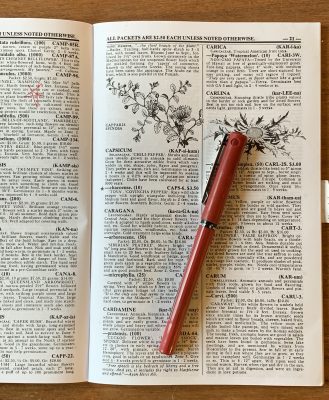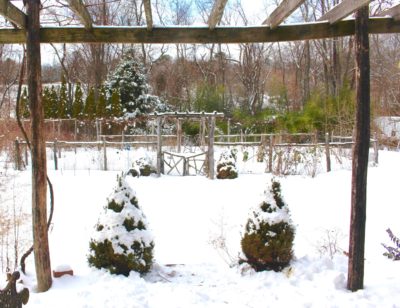Catalog and Weather Watchin’
Armchair Gardening
Pretty much the only “gardening” I’m doing now is thumbing through the seed catalogs arriving in dribs and drabs in my mailbox. I’ve ordered and received what I thought I’ll need, but you never know; maybe there something else interesting out there to grow.
Among the most fun of these catalogs, and strictly for the plant-crazed, is “The 2020 Ethnobotanical Catalog of Seeds,” which used to be called Hudson’s Seed Catalog. The catalog originates in the Santa Cruz mountains of California (once home to Ken Kesey) but offers seed from all corners of the world. Only recently have they come online, at www.jlhudsonseeds.net.

I’ve ordered from this catalog for decades, each winter pleasurably and slowly wading through the almost 100 black-and-white pages of small print listings of botanical names and descriptions. For this first run through the catalog, I sit poised with red pen, ready to make a star next to any seed listing that looks particularly interesting. After I go through the whole catalog once, I’ll re-examine all those starred listings and select which seeds to actually order and grow.
Judging from what I’ve so far starred, I seem this year to be drawn to scented plants. Achlys triphylla, also known as vanilla-leaf or sweet-leaf, is one such plant: “Dense spikes of tiny flowers held above the trifoliate fan-shaped leaves. Moist woods from B.C. to California. The sweetly fragrant leaves were highly valued by settlers, who hung bunches in their houses. Sow 1/4″ deep in rich woodland soil, and keep moist. Slow to germinate.”
Another is Adenophora lilifolia, also known as ladybells. This one is described as “sweet-scented light blue 1/2″ wide bell-shaped nodding flowers borne profusely in summer. Very hardy perennial to 1-1/2 to 3 feet, with round, heart-shaped basal leaves. Eurasia. Cultivated in Japan for the thick, edible roots. Germinates in 2 weeks.” For only $2.50 a seed packet, oodles of each of these plants can be growing in and perfuming my backyard this summer.
It’s not just visions of fragrant, comely, or tasty plants that make this catalog fun to read. Berkheya purpurea is native to Africa, with a common name Zulu warrior. How many plants conjure up an image like that!? The plant seems to me less warrior-like, with flowers that are large, silvery-blue to lavender daisies with dark centers. Interesting, but I don’t need another daisy for now.
Short quotes interspersed throughout the catalog set the tone and are food for further thought. Here’s one from Thomas Jefferson: “It does me no injury for my neighbor to say there are 20 gods or no God. It neither picks my pocket nor breaks my leg.” Or, going back 17 centuries, to Aesop: “Any excuse will serve a tyrant.” And then forward, to General Douglas MacArthur: “ If you win, you stand only to lose. War contains the germs of double suicide.” Or, to another American general, Dwight Eisenhower: “Things are more like they are today than they have ever been before.”
So far, I’ve only gotten as far as “D” in the seed listings. There’s still time.
Where’s Winter?
Aren’t temperatures supposed to get colder and colder and colder until the end of this month, and then get warmer and warmer and warmer? That’s how temperatures generally trend in coastal regions, near large bodies of water, and in western Europe. Not so here in the Hudson Valley and over most of continental North America.

In my garden, the low was 3 degrees in early December and the high was 59 degrees a couple of weeks ago. Such fluctuations are not that uncommon over much of continental U.S. If you don’t like winter, you welcome those balmy winter days; if you like winter and/or like plants, those balmy days make you shudder.
Plants that can take our cold weather like the weather to stay cold all winter. Each time temperatures warm, especially after we’ve had a spell of cool weather, these plants start to awaken slightly from their winter slumber. The closer to spring and the warmer the weather, the more they awaken. Problem is that the more awake a plant is, the more likely damage, even for a cold-hardy plant, from subsequent frigid weather.
All this makes a good case for growing native plants. They’re more used to our mercurial weather and know better than to let a winter warm spell entice them out of their slumber.
However, many cultivated plants are not native. I like to grow fruits, and any fits of warm weather in weeks to come are going to make me nervous about the apples, plums, hardy kiwis, and pears, all non-native and sometimes awakening early enough to be damaged by subsequent cold.
Blueberries, pawpaws, persimmons, raspberries, and mulberries should be fine. Let’s hope for steadily cold weather and plenty of snow for the rest of winter.

Older winter scene

